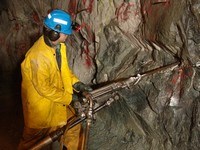Miners around the world at risk of contracting Raynaud Syndrome, or white hand disease, from using jackleg drills will soon be able to take advantage of an anti-vibration handle developed by Natural Resources Canada’s CANMET Mining and Mineral Sciences Laboratories, the University of Sherbrooke and the Institut de Recherche Robert-Sauvé en Santé et en Sécurité du Travail (IRSST).
The constant vibration from the jackleg drills reduces blood circulation in the hands and fingers, causing numbness and pain.
CANMET decided to tackle the problem in 2000 with the objective of developing a drill handle capable of reducing vibration by up to 50 per cent, said Marcel Laflamme, program manager, mine mechanization and automation.
A prototype was developed and manufactured by Parts Headquarters Inc., one of several Canadian manufacturers of jackleg drills. The anti-vibration handles were tested by Vale Inco and Goldcorp miners in Sudbury and Timmins, and at several mines in Quebec, but drew mixed reviews.
“Some miners found some inconvenience in how they had to hold the drill,” said Bill Quesnel, president of Parts Headquarters. “A miner gets used to operating a jackleg of one model and you have a hard time changing him to another model because the balance is different. When you’re lifting a 100-pound weight and working with it, you want to have the balance that you’re used to.”
A redesigned anti-vibration handle addressing the ergonomic complaints voiced by miners is scheduled to be finalized before the end of the year.
Jackleg drills have largely been replaced by drill jumbos in base metal mines, but are still used in narrow vein situations and for rockbolting.
“Thirty years ago, we gave the jackleg five years,” said Quesnel. “Twenty years ago, we gave it 10 years. Then, five years ago, we gave it 15. Now, we think it will be around for 25.”
In Sudbury, they’re used sparingly in narrow vein ore zones such as the Coleman Mine 153 orebody for rockbolting purposes, said Chris Bamberger, Vale Inco superintendent for All-Mines Training. They’re also used in some cases for reconditioning or drilling short holes to hang air and water services. Elsewhere in Canada, jacklegs are used in narrow vein gold mines. They are much more common in Russia, China, South Africa and South America.
Parts Headquarters has negotiated a licensing agreement with CANMET and the University of Sherbrooke to manufacture the anti-vibration drill handles, but also plans to sell the rights to other drill manufacturers.
Mining companies with an existing inventory of drills can retrofit them by purchasing a handle and backhead for one-third of the cost of a new unit, said Quesnel.
Raynaud’s Syndrome is a painful and debilitating condition.
“A lot of old timers have it,” said Bamberger. “You can tell right away. They have big hands. They rub them a lot and even when it’s hot out, their hands are cold. I’ve actually seen people having a beer and the beer slips out of their hand. They don’t even realize they’ve dropped it.”
Miners suffering from Raynaud’s Syndrome experience “a pinching, throbbing sensation, like hitting your thumb with a hammer,” he added.
CANMET is now conducting another study focusing on worker exposure to noise and vibration from a wide variety of mobile and stationary equipment, including jumbos, loaders, bolters, scissor lifts, graders and crushers, said Gilles LeBlanc, a mechanical engineer at the CANMET experimental mine in Val d’Or.
Researchers began measuring the noise and vibration from equipment at mines across the country in April and plan to complete their work before the end of the year.



